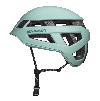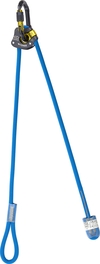Renzino Cosson, Mont Blanc du Tacul and the law of nature and the mountains
Interview with Renzino Cosson, mountaineer, mountain guide and Mont Blanc expert after the accident on Mont Blanc du Tacul which cost the lives of 8 mountaineers on Sunday 24 August. An occasion and analysis of the “rules” of nature and the spirit of mountaineering.

 1 / 3
1 / 3
Mont Blanc
 Francesco Tremolada
Francesco Tremolada
The outcome of the accident on Mont Blanc di Tacul, triggered by the collapse of a serac which early last Sunday swept away four German mountaineers, one from Austria and three from Switzerland now seems certain. And what now seems clear is that the accident which occurred on one of the most popular normal routes to the summit of Mont Blanc was not caused by inexperience or bad judgement.
Once again fatalities and risks awareness reconfirm themselves as being fundamental components of the mountains for those who take to them. We askd Renzino Cosson - mountain guide, expert mountaineer, hut keeper of Rifugio Bertone in Val Ferret and 20 year member of the Valle d'Aosta mountain rescue service - what happened and above all the “spirit“ which he was taught by years of mountaineering and mountain rescues.
Renzino Cosson, what impression did you get of the accident last Sunday on Mont Blanc du Tacul. Did it surprise you?
This isn't the first time that something similar happens on Tacul. A few years back 8 people were buried by a serac fall. One has to add that this time things could have been worse: at least 10 other mountaineers were involved, luckily without serious consequences. No, what happened did not surprise me: it's an integral part of the mountains, of mountaineering, of the route.
What is this route like and do you think the mountaineers were responsible for the tragedy?
Tacul unfortunately has always been a black horse for everyone, even if the ascent, when in condition, has no particular difficulties. In summer it can become dangerous after snowfall but above all if you're unlucky and fall into a crevasse… On Tacul, like on all other mountains, the rule holds true that nothing is ever easy. You always need to treat the mountain with respect, because it is she who dictates the rules, all we can do is adapt… But in this particular case it's impossible to say that the mountaineers made a wrong decision. On the contrary, the time of ascent and moment would have been perfect.
So what's the reason?
There is no reason. Tacul always presents dangers, you know that you have to ascend as quickly as possible because a serac fall can occur at any given moment. It's unpredictable: the weight of the mass never sleeps, is constantly on the move, perhaps unperceptable but nevertheless it's always in motion and when it has to fall it falls… this is the law of nature.
At times though one gets the impression that things have changed somewhat in the last couple of years…
The concept is as follows: 20 or 30 years ago you left Rifugio Torino to climb through the glacier traverse and you came across only a handful of other climbers. Now at times you can stand in line, and in good weather there are 200 or 300 teams who climb up Mont Blanc. The numbers have changed and with it also the probability of accidents. But I repeat, this has nothing to do with what happened last Sunday on Tacul.
At times one hears about mountains mutating due to climate change…
In truth this is one of the best seasons on Mont Blanc in years. But it's clear that conditions vary greatly from one year to the next and that something has mutated. For example the Normal route up Tour du Ronde is no longer feasible in summer…
Apart from what happened on Tacul, what has your mountaineering experience taught you?
Experience has taught me to take to the mountains and mountaineering saying: if conditions are good tomorrow then I'll do that climb, otherwise I'll turn back. My luck as Mountain Guide was to have carried out this style of mountaineering: we went to see if conditions were right, otherwise we turned back. In all these years I've backed off on numerous occasions, or because conditions didn't convince me, or because it simply wasn't the right day to climb because we weren't convinced or didn't feel up to it.
What attitude would you recommend therefore?
One has to do as the American Indians. To find water and food they had to listen to and interpret nature. Understand the signals. One needs this sensitivity. At times I think we've got exceptional climbing equipment, ice axes, crampons, ice screws which are perfect to use but, just like in the past, you still need to know how to walk along a crest. And above all not trip up, perhaps over our new crampons.
What do the mountains represent for Renzino Cosson now?
I've said stop to high mountains. I now enjoy the mountains by photographing them, I enjoy running my mountain hut. This too is a way of defending myself against the intrinsic dangers of Mother Nature. I've already played out all my lucky days in the mountains. I'd do it all again: the mountains were and still are my life teachers. When I returned from my ascents I was almost irritated by all those people with “their rules”, with what they had established as being the rules. I always felt more in harmony with the mountains, with those rules established only and exclusively by nature herself.
Once again fatalities and risks awareness reconfirm themselves as being fundamental components of the mountains for those who take to them. We askd Renzino Cosson - mountain guide, expert mountaineer, hut keeper of Rifugio Bertone in Val Ferret and 20 year member of the Valle d'Aosta mountain rescue service - what happened and above all the “spirit“ which he was taught by years of mountaineering and mountain rescues.
Renzino Cosson, what impression did you get of the accident last Sunday on Mont Blanc du Tacul. Did it surprise you?
This isn't the first time that something similar happens on Tacul. A few years back 8 people were buried by a serac fall. One has to add that this time things could have been worse: at least 10 other mountaineers were involved, luckily without serious consequences. No, what happened did not surprise me: it's an integral part of the mountains, of mountaineering, of the route.
What is this route like and do you think the mountaineers were responsible for the tragedy?
Tacul unfortunately has always been a black horse for everyone, even if the ascent, when in condition, has no particular difficulties. In summer it can become dangerous after snowfall but above all if you're unlucky and fall into a crevasse… On Tacul, like on all other mountains, the rule holds true that nothing is ever easy. You always need to treat the mountain with respect, because it is she who dictates the rules, all we can do is adapt… But in this particular case it's impossible to say that the mountaineers made a wrong decision. On the contrary, the time of ascent and moment would have been perfect.
So what's the reason?
There is no reason. Tacul always presents dangers, you know that you have to ascend as quickly as possible because a serac fall can occur at any given moment. It's unpredictable: the weight of the mass never sleeps, is constantly on the move, perhaps unperceptable but nevertheless it's always in motion and when it has to fall it falls… this is the law of nature.
At times though one gets the impression that things have changed somewhat in the last couple of years…
The concept is as follows: 20 or 30 years ago you left Rifugio Torino to climb through the glacier traverse and you came across only a handful of other climbers. Now at times you can stand in line, and in good weather there are 200 or 300 teams who climb up Mont Blanc. The numbers have changed and with it also the probability of accidents. But I repeat, this has nothing to do with what happened last Sunday on Tacul.
At times one hears about mountains mutating due to climate change…
In truth this is one of the best seasons on Mont Blanc in years. But it's clear that conditions vary greatly from one year to the next and that something has mutated. For example the Normal route up Tour du Ronde is no longer feasible in summer…
Apart from what happened on Tacul, what has your mountaineering experience taught you?
Experience has taught me to take to the mountains and mountaineering saying: if conditions are good tomorrow then I'll do that climb, otherwise I'll turn back. My luck as Mountain Guide was to have carried out this style of mountaineering: we went to see if conditions were right, otherwise we turned back. In all these years I've backed off on numerous occasions, or because conditions didn't convince me, or because it simply wasn't the right day to climb because we weren't convinced or didn't feel up to it.
What attitude would you recommend therefore?
One has to do as the American Indians. To find water and food they had to listen to and interpret nature. Understand the signals. One needs this sensitivity. At times I think we've got exceptional climbing equipment, ice axes, crampons, ice screws which are perfect to use but, just like in the past, you still need to know how to walk along a crest. And above all not trip up, perhaps over our new crampons.
What do the mountains represent for Renzino Cosson now?
I've said stop to high mountains. I now enjoy the mountains by photographing them, I enjoy running my mountain hut. This too is a way of defending myself against the intrinsic dangers of Mother Nature. I've already played out all my lucky days in the mountains. I'd do it all again: the mountains were and still are my life teachers. When I returned from my ascents I was almost irritated by all those people with “their rules”, with what they had established as being the rules. I always felt more in harmony with the mountains, with those rules established only and exclusively by nature herself.
Note:
| Links Planetmountain | |
| News Mont Blanc | |
| Mont Blanc - the best granite in Europe | |
Latest news
Expo / News
Expo / Products
Highly breathable skyrunning t-shirt
Light climbing helmet with kevlar reinforcements.
Adjustable lanyard for mountaineering and rock climbing by Climbing Technology
La Sportiva Jackal II are trail running shoes dedicated to the world of ULTRA races and long distance training.
Down sleeping bag for multi‑season trekking.
High quality suede gloves designed for via ferrata.



 Copia link
Copia link























